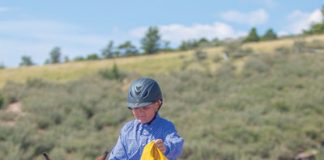Luke Gingerich gives some pointers for anyone interested in starting out in the appealing discipline of liberty work, which both horses and handlers can enjoy.
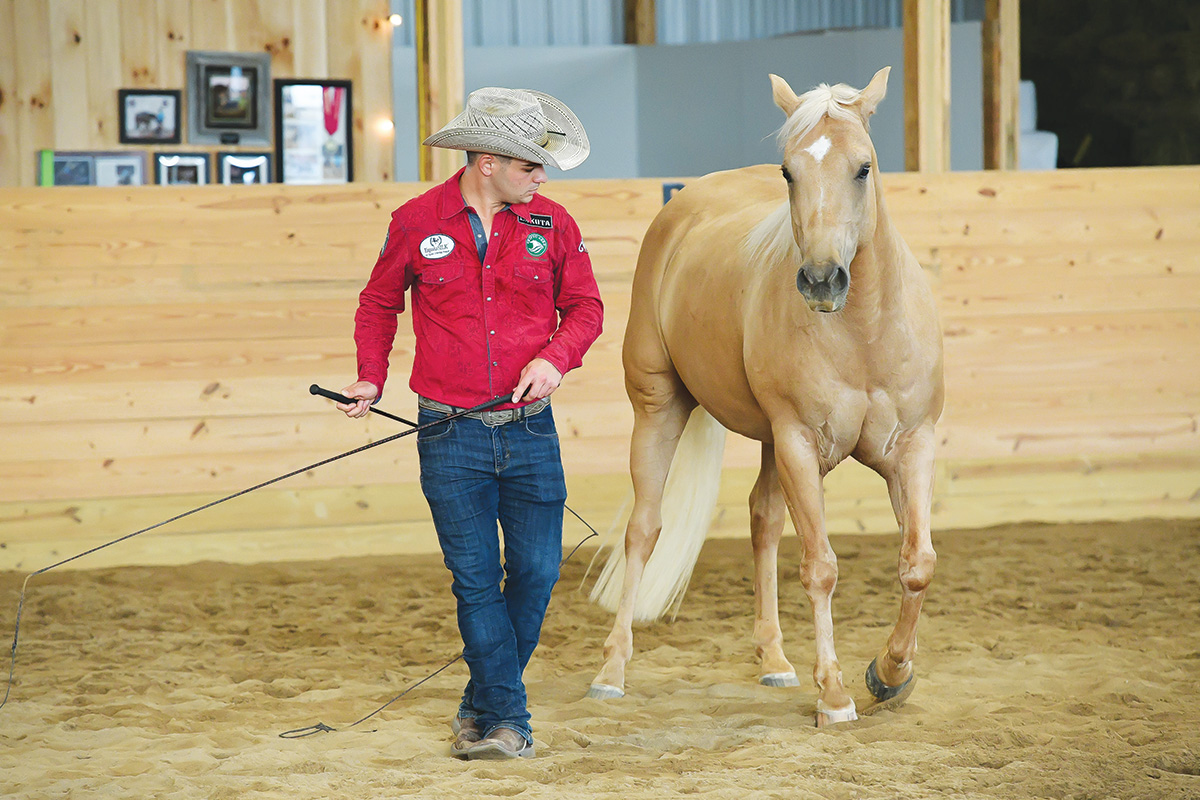
The performance is done at liberty, part of it working together on the ground and part of it bridleless under-saddle. Reining spins, flying lead changes, sliding stops, circles and lateral movements in step together on the ground, rearing and bowing on command, and more are intertwined into a mesmerizing show. It is awe inspiring, and the crowd loves it.
The man is Luke Gingerich, a rising star in the equestrian world, accompanied by his long-time partner, American Quarter Horse gelding CJ Rio Zan Bar Gun (aka “Rio”). The liberty work they do together may seem unattainable, but their dance is the result of lots of practice and finely tuned communication between the two.
Gingerich says it is something that most equestrians can learn to do with their horses, and he is on a mission to inspire and teach anyone who wants to work to achieve that goal.
“Liberty work requires a thorough understanding and awareness of your body language, timing, and feel, and how to use these to communicate with your horse,” he explains. “But it’s something that most anyone willing to put in the time, dedication, and consistency can experience with their horse.”
The Man Behind the Performance
Like many kids, Gingerich, who grew up in central Ohio, begged his parents for a pony. When he turned 10 years old, they purchased a mare named Misty for him. From then on, he was hooked. Several years later, he purchased his first Quarter Horse, a mare named Zippy; they competed in western pleasure and trail classes.
A fascination with liberty work from a young age led him to study with James Cooler in Summerfield, N.C. In 2017, he started training with Jesse and Stacy Westfall in Loudonville, Ohio, and he says that they have been a major influence in his horsemanship. A keen observer of equine behavior, he noticed that horses naturally want to be in sync with other members of their herd and do this by mirroring behavior of others in their group. He also saw how important body language is to horses in communication. He then applied these concepts to his training.
“I channel that desire and natural instinct to read subtle shifts and changes in body language to create complex maneuvers and behaviors that my horses become capable of doing at liberty with me,” he explains.
Performance Liberty Horsemanship
Helping horses learn how to use themselves correctly in a balanced and athletic way while working at liberty is also a personal mission. He is passionate about combining relationship-based training with training for high-level athleticism, and labels the combination of the two “performance liberty horsemanship.”
“Both the mental and emotional connection, combined with the physical body control and muscle memory that this work creates, can be directly carried over into riding in many competitive disciplines,” says Gingerich.
He’s put it all into practice in both training and competition. In addition to liberty exhibitions and competition, he competes in reining, freestyle reining, ranch versatility, and most recently, western dressage. He incorporates many dressage principles into his training.
In 2021, he brought 4-year-old palomino mare Tinseltowns Whizard (aka “Chloe”) to Quarter Horse Congress, where their bridleless freestyle reining routine earned them a large following.
Thus far, all of Chloe’s training under-saddle has been done without a bridle or reins or head gear of any kind. While Gingerich initially thought he would soon transition to tack, he was so pleased with how well Chloe’s foundation of liberty work carried over to ridden work during the first rides of her life that he has remained on the bridleless journey with her ever since.
In 2018, people started asking him to teach them how to do what he and his horses were doing, so he started a business, Luke Gingerich Horsemanship, in his hometown of Plain City, Ohio. In 2021, with the help of family and friends, Gingerich built a facility where he holds clinics and lessons.
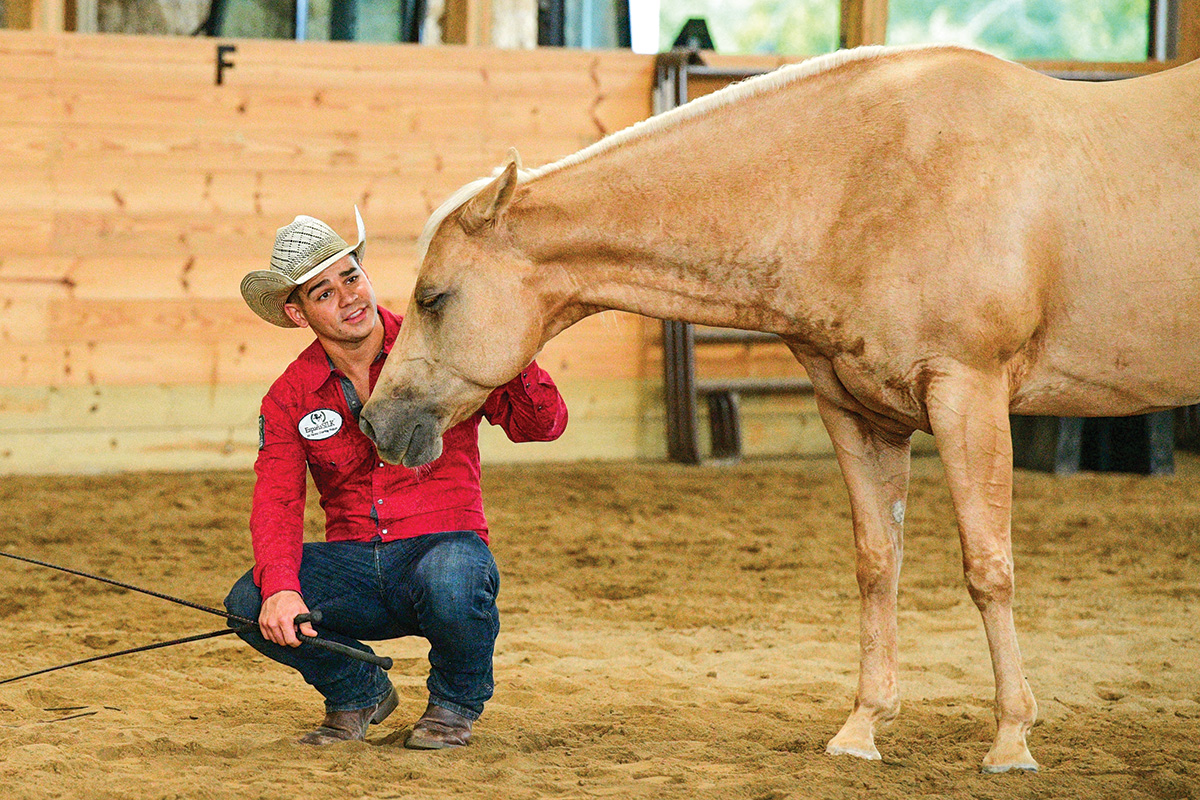
He has expanded his business by creating online training video library memberships. So far, he’s traveled to 20 states to compete, teach and perform, and has students from nearly all equestrian disciplines.
Why Liberty Work?
Almost any horse can do liberty work with proper training, at least at a basic level, says Gingerich. Yet, liberty work is more than just turning your horse loose in an enclosure and chasing them around.
“It should be more of a dance—a constant two-way communication with our horses—where we can guide and direct their thoughts and movements in an accurate, refined manner,” he explains.
He points out that liberty work gives horsemen and women a better connection with and understanding of their horses, serving to improve their relationship and results together. The horse will learn how to balance and use his body properly, which translates into improved under-saddle work. Not to mention that it can be just plain fun!
Preparing to Start Liberty Work
Gingerich advises doing homework before starting liberty work with your horse. Select an instructor for in-person and/or virtual learning. Watch liberty routines at shows, exhibitions and on videos and take note of what the human and horse are doing during their performance.
Find an appropriately sized work space, either a round pen, compact or subdivided arena, or a small, sturdy paddock. At first, work in-hand with your horse wearing a halter and lead. This provides more guidance and support as you start to learn how to communicate via body language what you would like your horse to do with you—move forward, stop, turn away or toward you, move around your body in a circle, change gaits, and so on. He explains that the way you move and angle your body, combined with consistent verbal cues, signals your intention to your horse.
He also uses three types of whips (dressage, carriage and longe whips) to offer guidance and support to the horse. He often carries two whips at a time and uses them to deliver separate signals to different parts of the horse’s body. Gingerich has found that the weight and balance of the whip is very important for allowing the cues to be as understandable and consistent as possible.
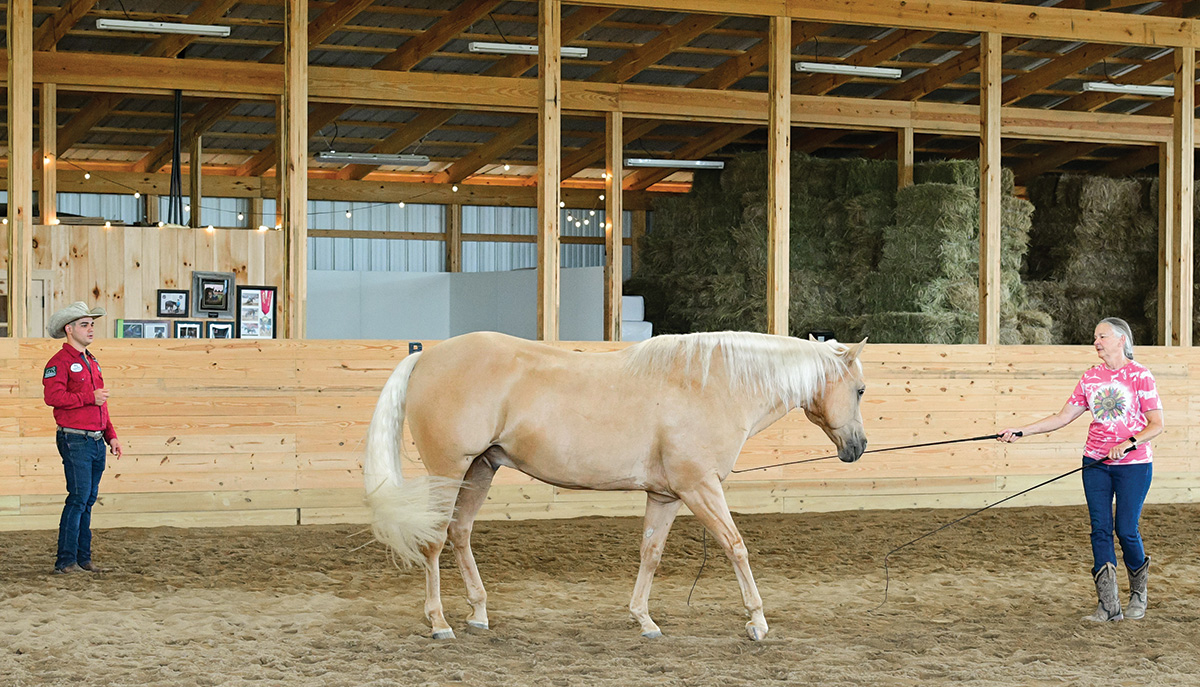
“Whips are an important tool when learning liberty work with your horse,” he says. “They are simply an extension of my arms to help me to be more clear and precise with the cues that I give my horse. Their function is similar to how our hands and legs function while riding, in that they can correct when necessary, yet should always be used to communicate and show my horse how to move and use his body, and how to find connection, focus, and relaxation under pressure—both physical and environmental.”
Before using the whips in work with your horse, practice learning to carry and control one with each hand so you can reliably send individual signals with each whip. The whip cues are used along with body language to ask the horse to do different movements.
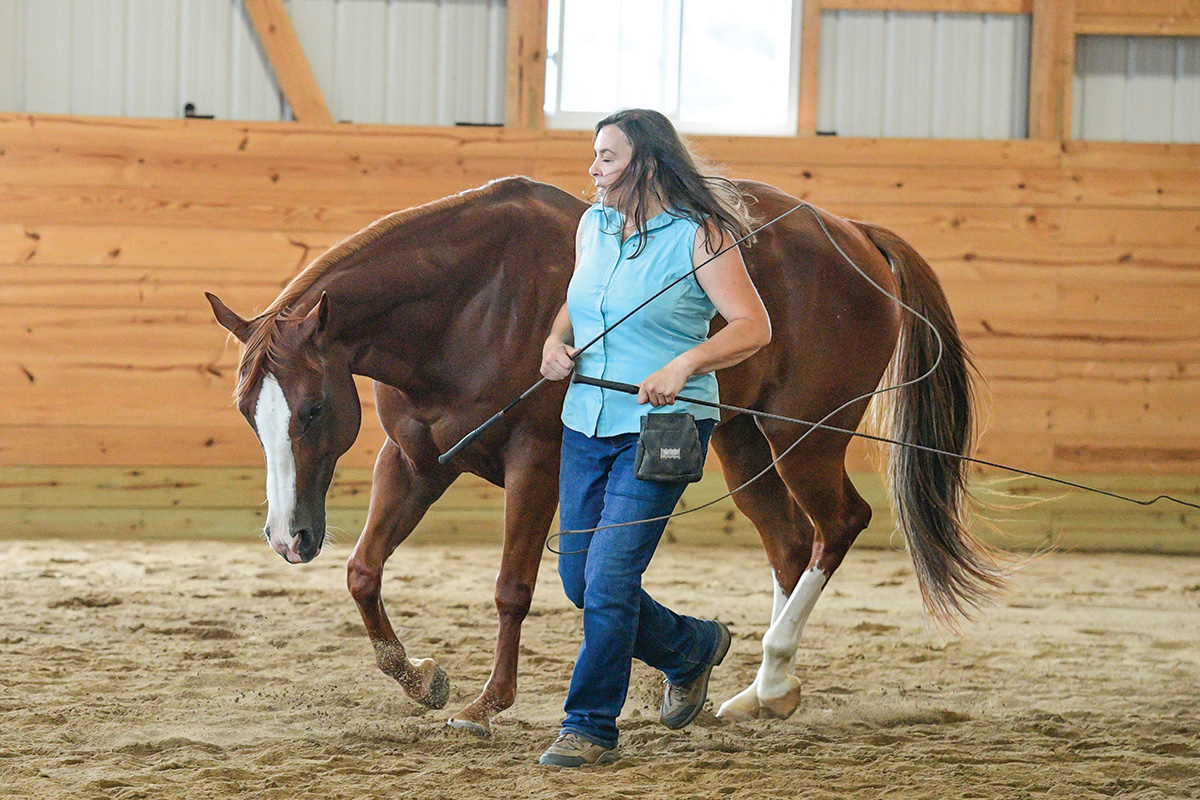
In planning for liberty work, you should also decide what types of rewards you plan to use to tell your horse that he has done a good job. The release of pressure at the correct time will always help your horse understand what is being asked of him. Pats, rubs, scratches, and verbal praise are all excellent rewards, and different horses appreciate some of these more than others.
Gingerich does incorporate clicker training, a form of positive reinforcement that involves using food rewards, into his program as he starts to move into more advanced work. But he cautions against introducing treats too quickly or offering them with poor timing, as this can cause problems with your horse.
Body Language is Key
Gingerich emphasizes that understanding the body language of both horses and humans is one of the most important aspects of being able to work at liberty.
“We need to have a clear understanding of the difference between drive and draw with our horses, which is instinctual for them,” he says. “Applying energy and pressure to our horses with the correct angles and feel in our bodies—and knowing when and how to release that pressure—is essential for clear communication, understanding and connection.”
His first lessons involve teaching people how to differentiate between driving, drawing, and neutral energy in their own body language. He explains each term this way:
◆ Drive is the intention in the person’s body language that asks the horse to move away from the handler.
◆ Draw is the intention conveyed by the person’s body that invites the horse to move toward the handler.
◆ Neutral energy is the handler holding his or her body in such a way that they do not ask the horse to change anything.
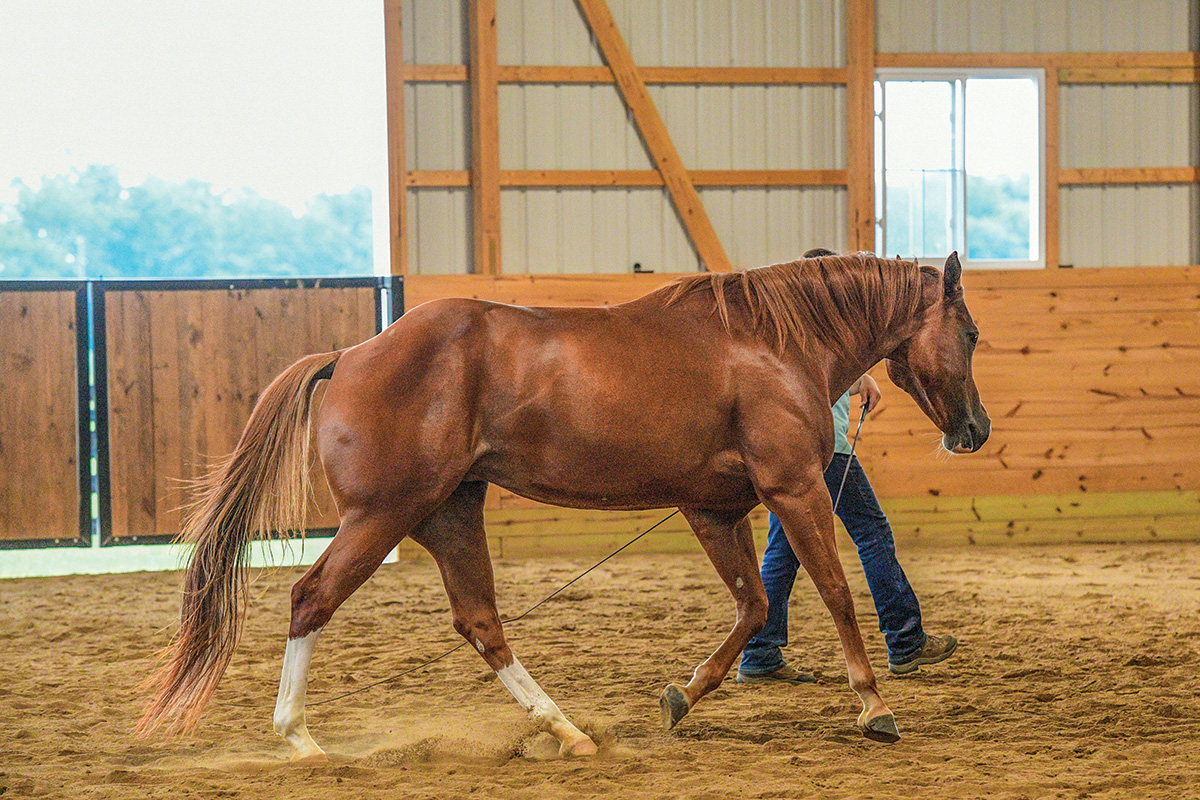
In most cases when working at liberty, Gingerich likes to be standing in a position by the horse’s head. This gives him a safer distance from the horse’s feet, and leaves more space between him and his horse, which allows him to communicate more easily since the horse is in a better position to see the cues he gives.
After teaching his students how to differentiate between drive, draw and neutral energy, Gingerich focuses on having them use these concepts to help their horses find connection, focus and relaxation.
Then he moves on to teaching body control. This involves the human learning how to use her body, and the whips, to show the horse how to move each part of his body independently, eventually without the need for a lead.
Basic Skills
One of the first things Gingerich teaches a horse is to back away when he applies pressure to the horse’s chest from the front. This helps ensure that he can adjust how close the horse comes to him as he advances in his training.
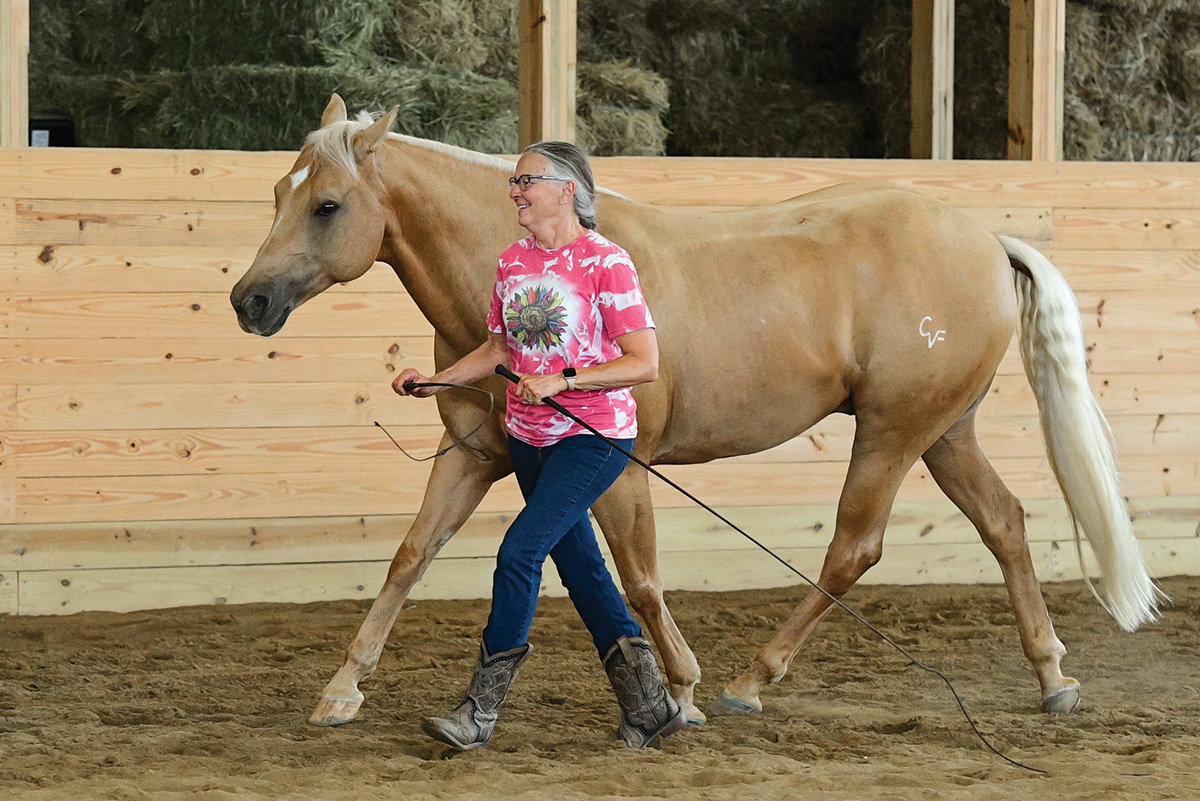
From there, he teaches the horse how to move his shoulders, hindquarters and rib cage independently in response to his body language. These basic skills help transition into starting liberty circles, lateral work, straightness training and so on. Teaching the horse to come when called is an important skill, too.
Gingerich advises keeping the training sessions short in most cases, especially at the beginning. Although a lesson can range anywhere from 15 minutes to over an hour, depending on the horse’s stage of training, 15 to 30 minutes is a good starting point.
He counsels to always try to end on a positive note with your horse. If the horse doesn’t master a task that you’ve asked for, go back to the basic skill set and end with a successful completion.
Safety Tips
As with any activity with horses, interacting safely is imperative in liberty work, too. Gingerich cautions to carefully read the horse’s body language for signals telling you to back off. A horse may be feeling playful, frightened, confused, annoyed or claustrophobic, which could cause him to lash out in your direction.
“My general rule is, when in doubt, increase the distance at which I am working with a horse, so we both have more space to safely read and respond to each other, and communicate from there,” says Gingerich.
To help you stay safe, he advises to first teach the horse that any part of his body you intend to draw towards you later must first be yielded away from you when asked. He feels that this is important to help everyone involved stay safe and confident. He also says giving cues with a longer whip can remind the horse to keep a safe distance.
Gingerich sometimes advises a handler to revert to work using a halter and lead to enhance safety.
“Liberty work requires a high level of education and understanding from both horse and human, so there are times that I will recommend that a horse and human use tack to help improve clarity, consistency, and communication before going back to working at liberty,” he says.
Advanced Liberty Exercises
Things to aspire to later in liberty work include teaching flying changes and to bow and rear on command. In his sessions with his own horses, they practice advanced movements such as straight-line flying lead changes, half-pass and pirouette at the canter, liberty spins, the cutting game, and a walking rear, among other cool moves.
With patience, practice and communication, you and your horse could dance like you mean it one day, too.
This article about liberty work appeared in the November/December 2022 issue of Horse Illustrated magazine. Click here to subscribe!




